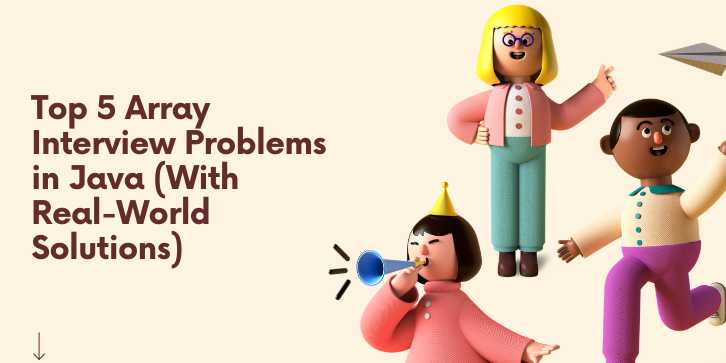Chapters
Top 5 Array Interview Problems in Java (With Real-World Solutions)

Overview
📝 Introduction (500–600
words)
Arrays are the foundation of programming, and in
Java, they play a crucial role in technical interviews — especially for entry-
and mid-level developers. They’re simple in structure, but deceptively tricky
when used in real-world algorithmic problems.
When preparing for Java interviews, you can expect at least
one question involving:
- Searching
or sorting within arrays
- Detecting
patterns or duplicates
- Manipulating
data in-place
- Understanding
time and space complexity trade-offs
Why are arrays so common in interviews?
Because they test your fundamentals — memory access,
control flow, loop logic, and algorithmic efficiency. Arrays are also a
stepping stone into more complex data structures like lists, stacks, queues,
and trees.
Java arrays have their own quirks:
- Fixed
size
- Static
typing
- Index-based
access
- Compatibility
with both primitive types (int[]) and objects (Integer[])
These characteristics make Java array problems both powerful
and sometimes frustrating.
This guide covers the Top 5 Java Array Interview Problems
that frequently appear in coding rounds and whiteboard interviews. But more
than just showing code, we'll explain:
- Why
a particular approach works
- What
common mistakes to avoid
- How
to improve your time/space complexity
🔍 What You’ll Learn:
- How
to solve array rotation problems in constant space
- How
to detect duplicates with and without extra memory
- How
to work with sorted vs unsorted arrays
- Tricks
for two-pointer and sliding window techniques
- Java-specific
syntax, edge cases, and built-in helpers
Each problem in this list comes with:
- Problem
statement
- Core
logic breakdown
- Optimized
solution in Java
- Sample
input/output
- Interview
tips
Whether you're targeting FAANG companies, fintech startups,
or preparing for college placements — these problems will sharpen your
problem-solving mindset and improve your ability to reason under pressure.
Ready to master arrays in Java like a pro? Let’s dive into
the challenges that really get asked — and learn how to crush them with
clean, confident code.
FAQs
1. Why are array problems so common in Java interviews?
Because
they test core programming logic, data handling, loops, and algorithm
efficiency.
2. What’s the difference between int[] and Integer[] in Java?
int[] is a primitive array; Integer[] is an array of objects (wrappers). The latter allows null values and works with collections.
3. Is it better to use Arrays or ArrayLists in interviews?
For fixed-size problems, use arrays. For dynamic data, ArrayList is better — but stick to arrays unless otherwise asked
4. What are common pitfalls in Java array questions?
Index out of bounds, mutating arrays while iterating, and forgetting that Java arrays have fixed size.
5. How do I remove duplicates from a Java array?
Use a Set for uniqueness or sort the array first and remove duplicates in-place using two pointers.
6. When should I use the two-pointer technique?
It’s great for sorted arrays, especially for problems involving pair sums, removing duplicates, and reversing data in-place.
7. How can I rotate an array in Java?
Use reversal techniques or cyclic replacements to do it in O(1) space.
8. What’s the time complexity of array search vs binary search?
Linear search = O(n); binary search = O(log n), but only on sorted arrays.
9. How do I handle negative numbers or large input arrays?
Always consider edge cases: empty arrays, one element, all duplicates, etc. Optimize with hashmaps or prefix sums where needed.
10. What libraries or classes help with arrays in Java?
Use Arrays.sort(), System.arraycopy(), Arrays.toString(), and Collections when applicable — but show the manual solution first in interviews.
Posted on 09 Apr 2025, this text provides information on Java Interview. Please note that while accuracy is prioritized, the data presented might not be entirely correct or up-to-date. This information is offered for general knowledge and informational purposes only, and should not be considered as a substitute for professional advice.
Similar Tutorials

Advanced Excel Charts Tutorial: How to Create Prof...
Learn how to create professional charts in Excel with our advanced Excel charts tutorial. We'll show...

Advanced Excel Functions: Tips and Tricks for Boos...
Are you tired of spending hours working on Excel spreadsheets, only to find yourself stuck on a prob...

Apache Flume Tutorial: An Introduction to Log Coll...
Apache Flume is a powerful tool for collecting, aggregating, and moving large amounts of log data fr...




Comments(0)